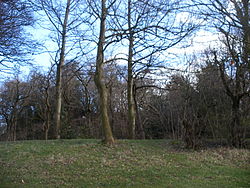Wakefield Castle
| Wakefield Castle | |
|
Yorkshire | |
|---|---|
 Earthwork and motte at Lowe Hill | |
| Location | |
| Grid reference: | SE32651968 |
| Location: | 53°40’21"N, 1°30’26"W |
| City: | Wakefield |
| History | |
| Information | |
| Condition: | motte remains |
| Owned by: | Wakefield City Council |
Wakefield Castle was a castle built in the 12th century, of which only the motte now remains, known as Lowe Hill or Lawe Hill (from the old word 'low' or 'law' meaning simply 'hill' or 'mound').
The castle on a hill on the north side of the River Calder near Wakefield. The mound, situated a quarter mile from the river, was separated from the town by flat swampy land and was seen as a good site for a fortification.
William de Warenne, 3rd Earl of Surrey probably started to build the castle, an earthwork motte and bailey structure. A ditch, six feet deep and forty feet wide was dug and the spoil used to construct a motte (a mound) about forty feet high with a flat top about fifty feet in diameter. The castle had two baileys further fortified by timber palisades and these were occupied by stables, workshops and sleeping quarters for the soldiers.[1][2]
Wakefield Castle and neighbouring Sandal Castle were granted to Thomas, Earl of Lancaster in 1318 and in 1324 King Edward II committed them to the care of Richard Moseley.[1] At what time the castle was destroyed is not known but a great gale in 1330 which caused much damage in Wakefield may have been the cause. Excavations in 1953 indicated that the castle was probably an adulterine castle, built without permission, and abandoned unfinished.[2][3]
In July 1558 a beacon was lit on Lowe Hill to warn the population that the Spanish Armada had been sighted off The Lizard in Cornwall. [4]
The castle today
Little remains of the castle. The remains though are protected as a Scheduled Ancient Monument,[2] and all is surrounded by Thornes Park, other than the motte which is covered in trees. The site is accessible to the public.[5]
Outside links
References
- ↑ 1.0 1.1 Walker 1966, p. 48
- ↑ 2.0 2.1 2.2 National Monuments Record: No. 52514 – Lowe Hill
- ↑ 1066-1600, Wakefield Council, http://www.wakefield.gov.uk/CultureAndLeisure/HistoricWakefield/History/1066-1600.htm?wbc_purpose=..., retrieved 2010-03-25
- ↑ Walker 1966, p. 414
- ↑ Wakefield Castle on Castle UK
- Mills, A. D. (1998), Dictionary of English Place-Names, Oxford, ISBN 0-19-280074-4
- Walker, J.W. (1966), Wakefield its History and People Vol.1&2 3rd Edn, S.R. Publishers